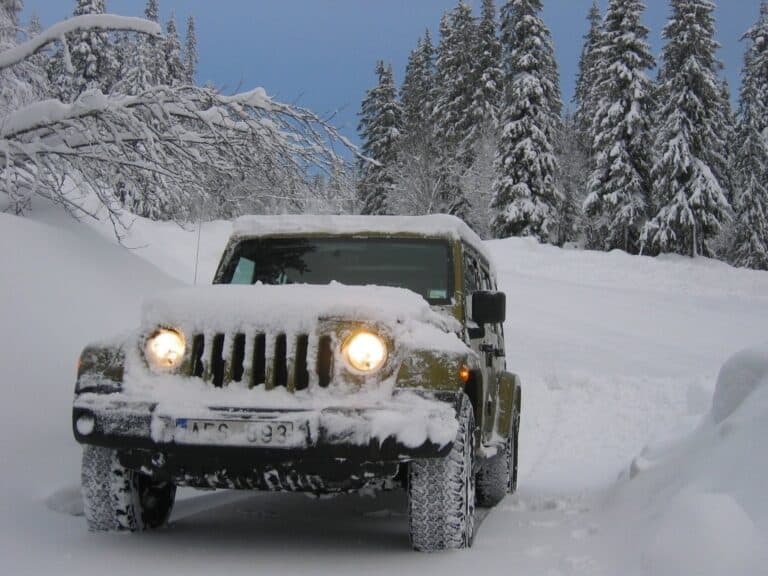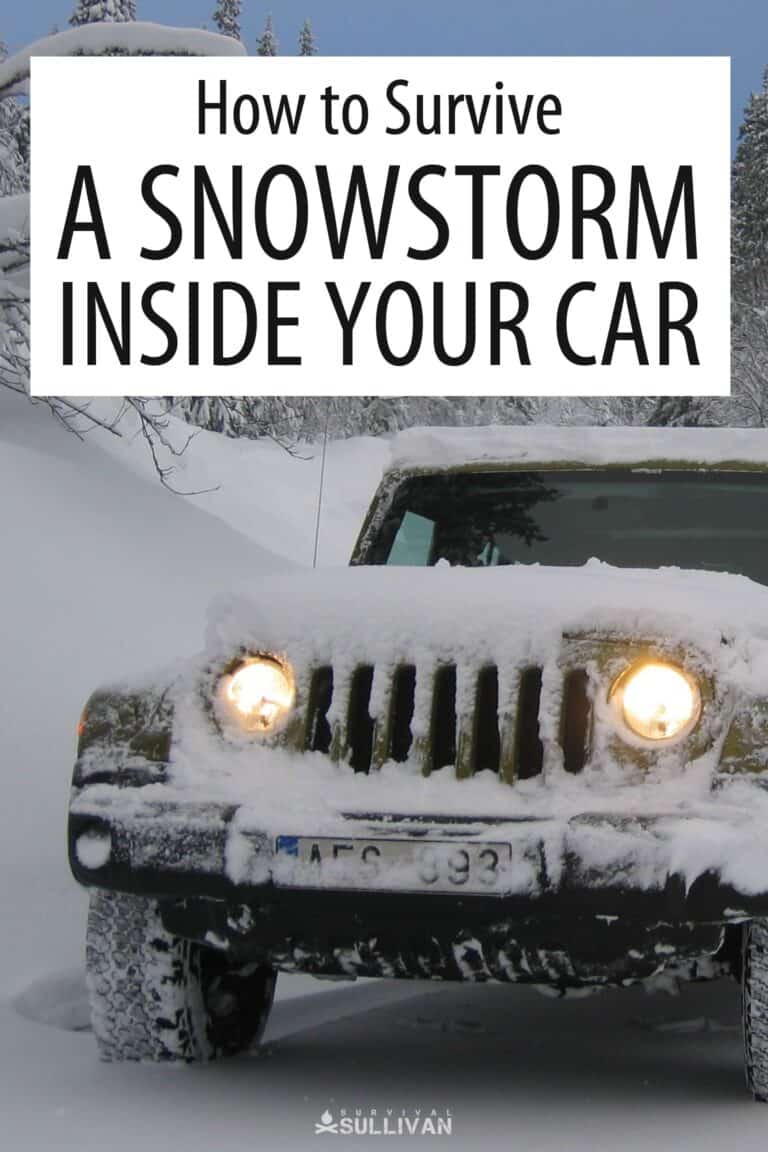Winter weather greatly complicates all sorts of tasks, and perhaps none more impacted than traveling by automobile. Snowstorms make paved surfaces incredibly slick and that means they are treacherous and dangerous for all sorts of automobiles.
The risk of crashing will be very high, and you should not discount the risk of becoming stranded on some out of the way or less traveled path. So how does one prepare for a snowstorm when traveling by car?

You prepare to survive a snowstorm by ensuring your vehicle is properly maintained, by equipping it with the appropriate winter driving accessories, equipping it with a winter survival kit and complement of roadside emergency parts and tools.
You’ll also need a fair bit of common-sense to survive on emergency in your vehicle during snowy conditions.
There’s quite a lot to unpack regarding this topic and we will be providing you with all the details in the remainder of this article. Grab your snow chains, pull on your coat and let’s get going!
Snowstorms Make Travel Dangerous
Significant winter weather makes traveling by automobile a risky proposition and a couple of ways. First, snow and ice are notorious for making paved surfaces incredibly slippery, massively increasing the risk of single or multi-vehicle accidents.
It never fails that the onset of winter sees a sharp spike in the number of crashes and attendant injuries and fatalities on America’s roads, and elsewhere around the world.
This is bad enough all on its own, but to compound those problems you’ll also have to worry about becoming stranded.
Everybody has heard stories about people becoming immobilized, crashing or getting lost and running out of fuel on some backwoods trail or lesser traveled highway during rough winter weather and then finding themselves in a legitimate survival situation.
This happens more than you think, but you might find yourself stranded in your vehicle far from any legitimate shelter or help as a result of a traffic jam or some other mishap.
For preppers, traveling in your vehicle away from your home also means that you are far away from your survival stash, most of the time, and that means you simply will not be as well equipped for dealing with any given emergency.
Exposure is one of nature’s single biggest and most reliable killers and though the prospect of spending time waiting out the storm or waiting for help in your vehicle might seem more of a novelty than anything else you should not delude yourself. Your life might soon be in danger.
Avoid Travel if You Can
The best way to avoid emergencies associated with winter weather when driving is to avoid driving during significant winter weather. If you have an elective trip planned, postpone it.
If you are driving and get overtaken by a snowstorm look for a place to pull over or just plan on putting in for the day. This is not always possible or expedient but it is your best option.
However, circumstances and Mother Nature both seem to have a knack for conspiring to force our hand even during perilous conditions. You must be especially cautious if you have to drive during any substantial snow storm, or the aftermath of one. The hazards will be many and they will be widespread.
So long as freezing temperatures are present black ice will be a perennial and insidious hazard, forming rapidly and invisibly on paved surfaces, particularly ones that are prone to freezing ahead of the rest of the roadways such as bridges, overpasses and other elevated surfaces.
Even without the constant threat of black ice snowfall and other precipitation will quickly create a lack of traction on the roads, a condition that even the most capable four wheel drive vehicles are ill-equipped to handle in a factory configuration.
In the event of a crash or just a total stoppage of traffic you will then be facing a survival situation in which you must shelter inside your vehicle and the average automobile is a poor shelter. The best way to handle such circumstances is by getting prepared now.
Ready Your Vehicle
A big part of winter survival in a vehicle is preparing your vehicle for such conditions. Winter temperatures, road salt and the aggressive braking and steering sometimes necessary to handle inclement conditions means your vehicle needs to be in tip-top shape when it comes to maintenance.
You should take care of all defects, broken parts and other shortcomings and stay on top of routine maintenance such as tires, brakes, seals, lights, wipers and so on.
It is also in your best interest to equip your vehicle if it is capable of utilizing them, with snow chains or cleats that can provide attraction even on roads that are completely covered with ice.
Not all vehicles can safely utilize these systems and furthermore they are not legal in all municipalities and states but despite the increased wear and choppy ride that results from using them they dramatically increase control and safety on slick surfaces.
By keeping your vehicle in the best possible condition to avoid an accident you’ll have gone far in preventing a roadside emergency.
Equip Your Vehicle with a Winter Survival Kit
Once you get your vehicle tuned up and ready for winter weather you will want to equip it with a winter survival kit containing items that can help you get your vehicle unstuck, and also keep you alive if you are forced to shelter inside your vehicle for any reason.
In this kit should be included such items as:
- sand or kitty litter for providing traction to tires resting on slippery surfaces,
- spare parts and tools necessary for handling common breakdowns,
- plenty of blankets,
- clothing and items to provide warmth,
- rations in the form of shelf stable and ready-to-eat food,
- a fireproof, metallic container,
- candles,
- road flares,
- marking triangles,
- a compact shovel and scraper,
- spare cell phone battery or power bank,
- a first-aid kit,
- and maps.
Your objective should be to remain inside your vehicle in comparative comfort as long as you can and have everything you need to wait for rescue or wait for the weather to clear.
Things might look pretty grim if you are stuck inside your vehicle on the side of the road during a snowstorm, but they can get even worse if you set out on foot ill-prepared.
Procedures
Let’s say the long-feared event has occurred. You are driving down the road when you are overtaken by a severe snowstorm and crash or are otherwise forced to stop. Traffic is starting to Peter out but lucky for you the engine still runs. What should you do now?
First things first, if you are near any major and high-speed road you should be very concerned about being struck.
Snow storms drastically reduce visibility and even when it isn’t snowing the whiteout effect is very real and chances are even a brightly colored car will not be easy to spot.
Deploy your marker triangles, brightly colored cloth flags or even road flares depending on the circumstances to improve your visibility and let people know you are in trouble.
Next, try to call for help. If you can’t or are determined to just wait the situation out you should run your engine for 10 to 20 minutes out of every hour in order to power the heater and warm up the cabin.
It goes without saying that you should don any additional clothing or blankets that you can in order to stay warm. Try to reserve the use of your emergency candles for night time visibility or the melting of snow though they will improve the temperature of the cabin however slightly.
One critical element that is often overlooked in this scenario is the importance of keeping the exhaust pipes of your vehicle clear while the engine is running. A blocked tailpipe can lead to deadly carbon monoxide gas filling the passenger compartment and poisoning you along with everyone else inside.
Carbon monoxide is an insidious killer and often takes effect when people are sleeping, never to wake up. You’ll need to get out of the car periodically to shovel snow from around the exhaust pipe and door jambs. Take care to keep the vehicle clear of snow also to improve visibility.
Conclusion
Winter survival is tough enough without the complications imposed by vehicular travel. Snow storms and other winter weather can make even a comparatively short drive a major hazard, and can see you stuck in a legitimate survival situation.
You can improve your chances of making it through winter weather when driving by properly maintaining your vehicle, equipping it for safe driving during slick conditions and stowing an emergency kit specific to winter conditions on board.


Tom Marlowe practically grew up with a gun in his hand, and has held all kinds of jobs in the gun industry: range safety, sales, instruction and consulting, Tom has the experience to help civilian shooters figure out what will work best for them.
